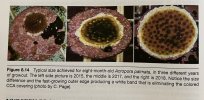TetrisPetris
Guest
Hi reefers!
I'm an engineer and erstwhile reefkeeper working with a nonprofit to investigate new technology in coral farming to help restore reefs. I posted a bit back about cultivating nuisance algae to experiment on which received some really helpful replies, and now I'm investigating the potential for using coralline algae to help reduce the need to clean hair algae in coral farms.
Since some context is helpful, here's a link to a little doc where I typed up a few thoughts, or here's a TLDR version:
I'm thinking about a few approaches like breaking up live coralline algae and gluing a bunch of fragments of it to a frag plug (like a salted margarita rim), with the idea that only a little more growth would need to happen for complete coverage. I'm also thinking about trying using high concentration purple helix on some frag plugs to seed them with a crazy amount of spores, maybe in conjunction with purple up to help accelerate growth.
I'd love to hear the community's thoughts about how to approach this!
Also shoutout to Michael (@H2OPlayar) for generously meeting up with me and offering to host some experiments
Thanks very much!
Peter
P.S. If you'd rather chat than type I'd be happy to! Just PM me and we can find a time
P.P.S. If you're curious about reef restoration, it's getting to be a pretty exciting and important topic!
I'm an engineer and erstwhile reefkeeper working with a nonprofit to investigate new technology in coral farming to help restore reefs. I posted a bit back about cultivating nuisance algae to experiment on which received some really helpful replies, and now I'm investigating the potential for using coralline algae to help reduce the need to clean hair algae in coral farms.
Since some context is helpful, here's a link to a little doc where I typed up a few thoughts, or here's a TLDR version:
- Reefs are rapidly dying due to climate change
- Some individual coral have high temperature resistance and are able to survive mass bleaching events, but the population remaining on a given reef is often below extinction threshold
- The marine biology community believes that active restoration could be the answer - planting breeding populations of temperature-resistant coral
- The size of the intervention needed is massive, so efforts need to be scaled up dramatically with cost per coral lowered dramatically
- The most significant labor cost in large scale coral farming is often manual algae removal (because it can choke coral)
- Algae overgrowth is a problem partly because farms will need to use natural natural sunlight and seawater (variable and sometimes nutrient-rich) for cost reasons
- Natural grazers can help, but balancing populations across many tanks can become a significant logistical hurdle, so preventing algae growth (particularly near growing coral) would be a huge help
- Coralline algae looks promising because it can deny substrate to nuisance algae while being easy for coral to grow on, but it grows very slowly
I'm thinking about a few approaches like breaking up live coralline algae and gluing a bunch of fragments of it to a frag plug (like a salted margarita rim), with the idea that only a little more growth would need to happen for complete coverage. I'm also thinking about trying using high concentration purple helix on some frag plugs to seed them with a crazy amount of spores, maybe in conjunction with purple up to help accelerate growth.
I'd love to hear the community's thoughts about how to approach this!
Also shoutout to Michael (@H2OPlayar) for generously meeting up with me and offering to host some experiments
Thanks very much!
Peter
P.S. If you'd rather chat than type I'd be happy to! Just PM me and we can find a time
P.P.S. If you're curious about reef restoration, it's getting to be a pretty exciting and important topic!


